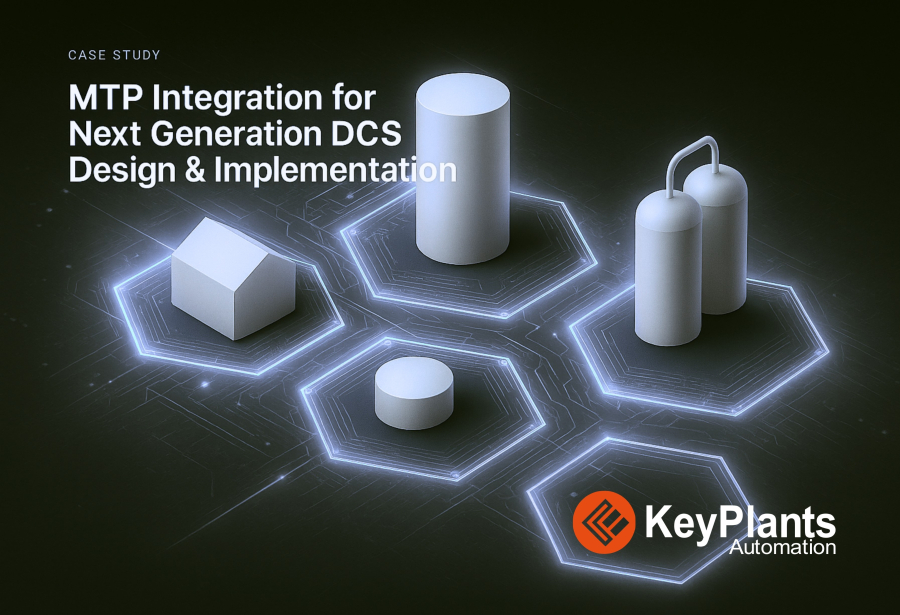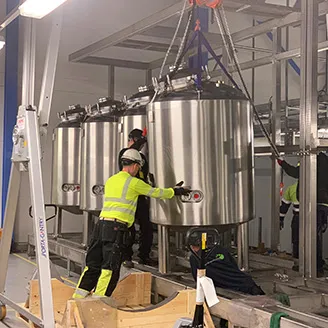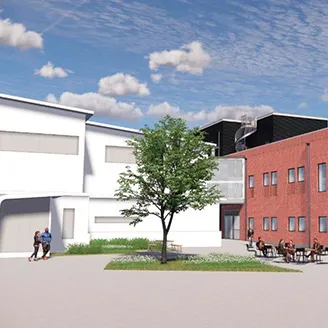Reference PROJECTS
From Pilot to Production: First-of-its-Kind MTP Deployment in the Nordics
Project details
Project details
Client
Confidential Global Pharma Client
Location
Sweden
Market
Pharmaceuticals & Biologics Manufacturing
Solutions we provided
Implementation of a Modular Type Package (MTP)-based automation architecture including a UMS and integration of MTP-ready utilities.
Executive Summary
Executive Summary
This case study details the successful implementation of a Modular Type Package (MTP)-based automation architecture in a greenfield life sciences facility. Delivered by KeyPlants in collaboration with Masco Group sister companies, the project leverages Siemens PCS neo and MTP-ready process equipment to enable true plug-and-produce integration.
Driven by the client’s ambition for a flexible, scalable, and future-proof system, the team implemented a Utility Management System (UMS) that simplifies integration, reduces engineering workload, and accelerates commissioning. A pilot deployment of a door interlock system demonstrated real-world viability, marking the first known MTP implementation of its kind in the Nordic region.
The modular architecture now enables seamless onboarding of new equipment, simplifies validation in regulated environments, and lays the groundwork for future expansion and digital twin integration. Key enablers included OEM support for MTP, strong system integrator expertise, and early stakeholder alignment around modular thinking.
This case serves as a practical benchmark for manufacturers seeking to modernize their automation strategy and adopt MTP as a foundation for long-term agility, compliance, and operational efficiency.

Understanding MTP
Modular Type Package (MTP) is a platform-agnostic, industry-driven standard developed to enable plug-and-produce integration of modular process equipment into higher-level automation systems.
Unlike traditional monolithic automation architectures, MTP promotes a decoupled, service-oriented approach where individual skids or functional units are engineered, automated, and delivered as self-contained modules. Each module is accompanied by a standardized MTP file—a metadata package containing functional descriptions, HMI templates, and communication interface definitions. These files are imported into theProcess Orchestration Layer (POL) of your automation platform, allowing system integrators to automatically generate consistent operator interfaces, alarms, and interlock configurations without duplicating engineering efforts.
From a lifecycle perspective, MTP significantly reduces integration effort, especially in multiproduct facilities, late-stage project changes, or expansion scenarios. It supports modular production strategies and aligns well with the ISA 88/95 frameworks, making it especially relevant in the life science and pharmaceutical sectors where flexibility, validation traceability, and system segregation are critical.
Example - MTP vs Traditional Automation
Imagine integrating a simple skid into a production facility:
- Traditional Approach:
- The system integrator receives P&IDs and I/O lists from the skid vendor.
- The integrator must manually configure all signals, control logic, HMI graphics, and alarms in the DCS or SCADA system.
- Any design change or logic update requires back-and-forth between teams and is time-consuming and error prone.
- MTP Approach:
- The vendor delivers the same skid plus a standardized MTP file.
- The MTP file is imported into the orchestration layer (e.g., PCS neo MOL), which automatically generates the control interfaces, HMI, and alarm configuration.
- Integration is quicker, changes are localized, and modular testing is easier — all without rewriting code in the central DCS.
The Project
Following the client’s ambition for modern, flexible, and modular automation architecture, this project centers on the development of a Utility Management System (UMS) built on Siemens PCS neo and integrated with MTP-ready process equipment. The system is being delivered to a newly built life science production facility by KeyPlants AB, in close collaboration with our sister companies within Masco Group—Stilmas, the OEM for the process skids, and Masco Group Automation (MGA), responsible for control and skid-level automation.
The final system architecture is based on PCS neo, Siemens’ web-native DCS platform, which includes integrated visualization functionality for selected process areas. This setup enables distributed engineering, centralized lifecycle management, and standardized module integration—all essential capabilities for building a modular automation platform that supports rapid change and long-term maintainability.
To meet the client’s requirements, we leveraged the Modular Type Package (MTP) standard to enable plug-and-produce integration of key process utilities, including a WFI skid and a clean steam generator. These were delivered as standalone MTP modules, ready to be orchestrated within the UMS using the PCS neo orchestration layer.
Prior to integrating the full process skids, we executed a pilot implementation of MTP together with the client. This pilot focused on a door interlock system and served as both a proof of concept and a capability demonstration—validating our competence in modular engineering and MTP-based integration. It also marked the first known MTP implementation of its kind in the Nordic region, with all system development performed by KeyPlants Automation at our headquarters in Stockholm.
Adoption Drivers and Enablers
The successful implementation of MTP in this project was not only a result of forward-leaning technology, but it was also enabled by alignment across all key stakeholders. The following drivers and enablers made this project feasible and reflected what future adopters should consider when planning similar initiatives:
Modularization of Production Equipment
The availability of vendor-supplied, modular skids was a foundational capability. It provided the physical and logical structure necessary for realizing plug-and-produce integration using the MTP standard.
Vendor Adoption of MTP in Deliveries
The inclusion of MTP interface descriptions and files by the OEM facilitated standardization throughout the automation lifecycle—a crucial enabler for efficient integration and long-term maintainability.
Growing Competence Among System Integrators
System integrator experience with orchestration strategies and module integration patterns ensured a smooth project execution and minimized engineering overhead.
Regulatory Alignment Through Functional Segregation
MTP’s native support for module separation supported validation and compliance efforts—an important motivating factor in regulated industries like pharmaceuticals.
Plug-and-Produce Integration for Operational Flexibility
The ability to add, update, or replace process equipment with minimal reengineering offered a clear business advantage—motivating the shift to modular automation.
Clear Demand from Producers for Modular Plants
The customer’s vision and explicit requirements for a flexible and scalable architecture gave all stakeholders a mandate to innovate—serving as a primary driver behind the adoption of MTP.
Results and Benefits
The implementation of a modular, MTP-based automation architecture at this greenfield life sciences facility delivered tangible benefits across both engineering execution and future system flexibility. This first-of-its-kind deployment in the Nordics validated key MTP concepts in a real-world, regulated environment.
Key outcomes included:
Reduced Engineering Effort through Standardization
Integration logic, HMI, and alarms were auto-generated from MTP files, minimizing redundant development and enabling faster system configuration within PCS neo.
Successful Pilot of MTP for Door Interlock System
The project validated MTP’s viability through a functional door interlock pilot, confirming its suitability with GxP-compliant access and safety requirements.
Streamlined Vendor Integration of MTP-Ready Utilities
Pre-configured MTP modules from the WFI and clean steam skid suppliers enabled harmonized interface definitions, reducing effort during integration and testing.
Accelerated Testing via Virtual Commissioning
The use of SIMIT together with PCS neo allowed early validation of control logic, reducing time spent during onsite commissioning and improving quality assurance.
Enhanced Collaboration Across Stakeholders
The clear module definitions and standardized interface documentation improved coordination between the OEMs, automation team, and end customer — a key success factor.
Scalable Architecture for Future Expansion
The MTP-based design now serves as a plug-and-produce foundation for future additions. New equipment can be onboarded with minimal engineering, shortening the lead time for facility updates or capacity changes.

Key Learnings and Future Outlook
This project illustrates how MTP, coupled with a modular automation platform like PCS neo, can accelerate innovation in life sciences manufacturing while preserving compliance and control. It also reinforces the importance of collaboration between all stakeholders — OEMs, system integrators, and the end user — as a critical success factor for modular implementations.
With the modular foundation now in place, the client is well-positioned for future scaling and adaptation. As production needs evolve or new utilities and process units are introduced, these can be integrated with minimal rework — simply by leveraging the established MTP interfaces and orchestration framework. This plug-and-produce capability creates long-term agility and simplifies lifecycle maintenance.
Looking further ahead, we see a clear synergy between MTP and the growing adoption of digital twins. While MTP provides a standardized operational interface for physical modules, digital twins offer a dynamic, real-time representation of these modules across their lifecycle. When combined, they can enable:
Predictive simulations of new modules before physical deployment.
Faster and safer validation of control strategies using virtual commissioning.
Smarter orchestration by connecting digital representations with live process data for optimization and troubleshooting.
As modularization and digitalization continue to converge, the combination of MTP and digital twins will likely become a cornerstone in the next generation of smart, flexible manufacturing — particularly in regulated industries like pharma, where adaptability and compliance must go hand in hand.




